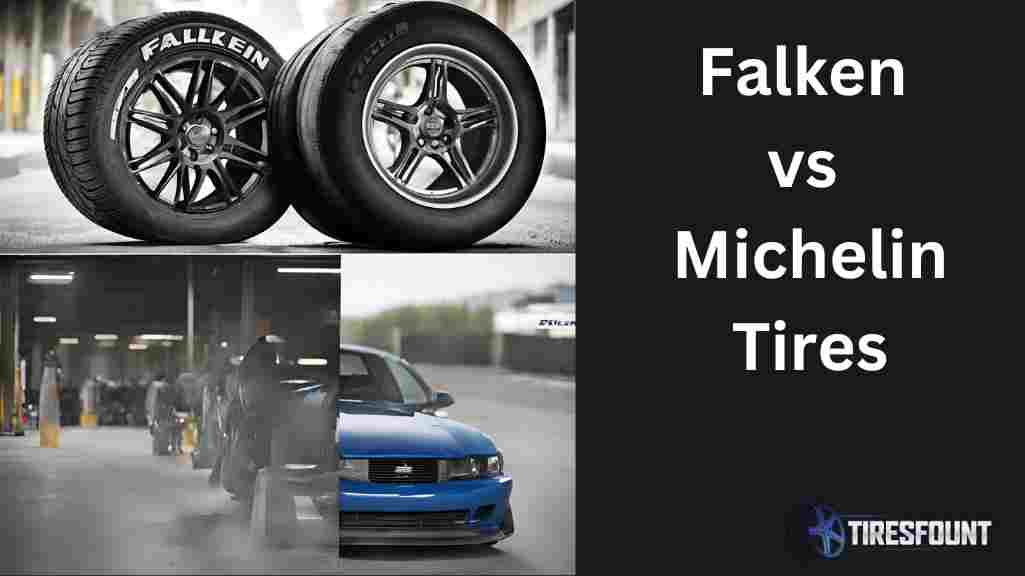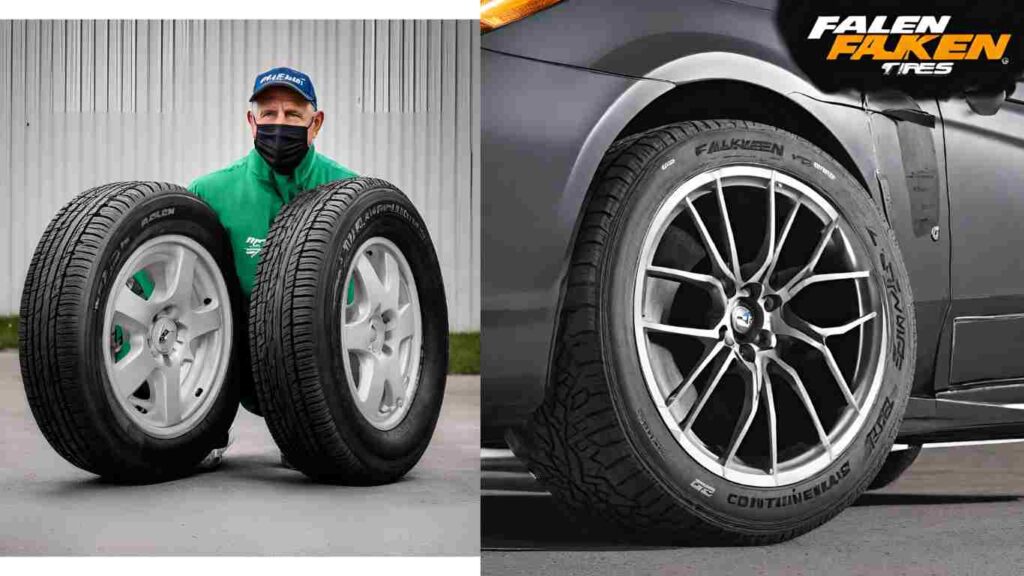Established in 1983, Falken Tire Corporation began as a subsidiary of the Japanese tire manufacturer OHTSU Rubber & Tire. It quickly grew to become a prominent player in the tire industry.
And, founded in 1889 in France, Michelin is one of the world’s largest tire manufacturers. It pioneered radial tire technology in 1946.
They both are good, but what are the differences between Falken and Michelin? Michelin prioritizes premium performance, boasting superior traction, handling, and comfort.
On other hand, Falken offers commendable performance at a more accessible price point.
Michelin integrates advanced technologies like EverGrip and 3D Sipes, while Falken utilizes 4D Nano Design and Canyon Sipes for innovation.
Michelin is known for exceptional quality and durability, providing a smooth ride, whereas Falken delivers a balance of performance and value, catering to a diverse range of drivers.
In this guide, you’ll learn how they differ from each other. Read to know how good they are in different conditions.

Comparison Table of Falken VS Michelin Tires
Here’s a detailed comparison table highlighting the key differences between Falken and Michelin tires, covering different features.
| Feature | Falken Tires | Michelin Tires |
| Performance | Good performance at a more budget-friendly price | Premium performance with a focus on quality and durability |
| Dry Cornering | Provides decent grip and stability in dry conditions | Known for exceptional dry cornering capabilities |
| Wet Cornering | Offers satisfactory traction and handling in wet conditions | Excels in wet cornering with superior grip and stability |
| Ride Quality | Generally provides a comfortable ride | Known for a smooth and quiet ride with excellent comfort |
| Lateral Grip | Offers good cornering performance at a lower cost | Provides superior lateral grip and precise handling |
| Technology | Utilizes innovative technologies for performance | Incorporates advanced technology for performance and safety |
| Sidewall Design | Often features aggressive designs | Emphasizes sleek and sophisticated aesthetics |
| Mileage Warranty | Typically offers shorter warranties compared to premium brands | Offers extensive mileage warranties for added assurance |
| Overall Quality | Provides a good balance of performance and value | Renowned for exceptional quality, durability, and performance |
| Costs | Generally more budget-friendly compared to premium brands | Often comes at a higher price point for premium quality |
Detailed differences guide of Falken VS Michelin Tires

Falken and Michelin are reputable tire brands offering diverse options. This guide outlines detailed differences in various aspects.
Note: Here I will give some examples for each brand to clarify the idea better.
Performance on-road
Michelin tires are often praised for their excellent on-road performance, including precise handling, good traction in both dry and wet conditions, and a smooth, comfortable ride.
For example, the Michelin Pilot Sport 4S is a high-performance tire designed for sports cars, luxury sedans, and high-powered vehicles.
It features an advanced tread compound and asymmetric tread pattern, optimized for excellent grip on dry and wet roads.
Falken tires also provide solid on-road performance at a more affordable price point. The Falken Azenis FK510 is a high-performance summer tire known for its balance of performance and affordability.
It incorporates Falken’s advanced 4D Nano Design technology, which enhances grip and traction on dry surfaces while maintaining stability in wet conditions.
Comparing the on-road performance of these two tires, the Michelin Pilot Sport 4S generally outperforms the Falken Azenis FK510 in terms of sheer grip, handling precision, and overall driving experience, especially in high-performance vehicles.
The Pilot Sport 4S provides a more refined and confidence-inspiring ride, particularly during aggressive cornering and acceleration.
Performance Off-road
When it comes to off-road performance, both Falken and Michelin offer tire options tailored to different types of terrain and driving conditions.
Michelin doesn’t have as extensive a lineup of off-road-specific tires as some other brands.
However, they do offer options like the Michelin LTX A/T2 and the Michelin Defender LTX M/S, which are designed to provide a balance of on-road comfort and off-road capability.
These tires typically feature aggressive tread patterns, reinforced sidewalls, and durable rubber compounds to handle rough terrain, gravel, mud, and light snow.
On the other hand, Falken has a range of tires specifically designed for off-road enthusiasts.
The Falken Wildpeak series, including the Wildpeak A/T3W and Wildpeak M/T, are popular choices for off-road adventures.
In terms of off-road performance, Falken tires often excel in providing superior traction and durability in challenging off-road conditions compared to Michelin tires.
They are designed to withstand the rigors of off-road driving while still offering acceptable on-road comfort and handling.
Noise
Michelin tires are often praised for their quiet and comfortable ride. Michelin engineers their tires with advanced tread designs and materials to minimize road noise and vibrations.
They employ technologies like the “Comfort Control Technology” or “Silent Rib” to reduce noise levels, resulting in a quieter driving experience. This focus on noise reduction contributes to Michelin’s reputation for providing a refined and comfortable ride.
Falken tires, while generally offering good performance and value, may exhibit slightly higher noise levels compared to Michelin tires, especially in certain models.
Some Falken tire models, particularly those designed for high-performance or off-road use, may have more aggressive tread patterns, which can contribute to increased road noise.
Technology
Both Falken and Michelin incorporate advanced technologies into their tire designs to enhance performance, safety, and durability.
Michelin is known for its continuous innovation in tire technology. Some of the key technologies found in Michelin tires include,
EverGrip Technology: This technology consists of expanding rain grooves and emerging grooves that widen and new ones appear as the tire wears, helping maintain traction in wet conditions even as the tread wears down.
3D Sipes: Michelin utilizes 3D siping technology to provide biting edges for improved traction on wet and snowy roads while maintaining stability and handling.
Green X Technology: Michelin’s Green X Technology focuses on optimizing fuel efficiency by reducing rolling resistance without sacrificing performance.
Comfort Control Technology: This technology is aimed at reducing road noise and enhancing ride comfort by optimizing tire construction and tread design.
Falken also employs innovative technologies in its tire designs. Some notable technologies found in Falken tires include:
4D Nano Design: Falken’s 4D Nano Design technology optimizes tire compounds at the molecular level, improving grip, handling, and tread life.
Canyon Sipes: Falken’s Canyon Sipe technology increases the number of biting edges for enhanced traction on wet and snowy roads while maintaining stability.
Heat Diffuser Technology: This technology disperses heat efficiently, helping to reduce tire wear and maintain optimal performance, especially during high-speed driving.
Adaptive Constant Pressure (ACP): ACP technology optimizes the contact patch of the tire, ensuring even wear and consistent performance throughout the tire’s lifespan.
Sidewall design
Michelin often emphasizes a sleek and sophisticated sidewall design that reflects the brand’s reputation for premium quality and luxury.
Michelin tires typically feature clean lines, subtle branding, and sometimes even sidewall reinforcements that enhance the tire’s appearance and performance.
The sidewalls of Michelin tires are often designed to complement the overall aesthetic of the vehicle they are intended for, whether it’s a sports car, luxury sedan, or SUV.
Falken, on the other hand, tends to adopt a more aggressive and dynamic sidewall design, especially in their performance and off-road tire lines.
Falken tires may feature bold lettering, intricate patterns, and sidewall reinforcements that convey a sense of ruggedness and durability.
The sidewall designs of Falken tires often reflect the brand’s focus on performance and adventure, appealing to enthusiasts and off-road drivers.
Mileage warranty
Michelin offers guarantees on how long their tires will last. If the tread wears out before the guarantee, you can get a credit for new tires. Here are the guarantees examples for different types of tires:
Michelin Defender: Up to 90,000 miles
Michelin Primacy All Season: Up to 55,000 miles
Michelin Defender T + H: 80,000 miles
ZP (Zero Pressure) tires: Up to 30,000 miles
PAX® System tires: 36,000 miles.
Check their warranty information for more info.
And on other hand, Falken is really confident in their products, like their SINCERA SN250 A/S tire.
It comes with an impressive Limited Tread Life Warranty of up to 80,000 miles, which is the highest for any Falken tire.
You can find more details about their warranty on their website.
Final Recommendations
Both Falken and Michelin have distinct strengths and histories in the tire industry. While Michelin is renowned for its premium performance and innovation, Falken offers a balance of performance and value.
Choosing between them ultimately depends on your specific needs, preferences, and driving habits. Whether you prioritize top-tier performance or seek reliable performance at a lower cost, both brands offer quality tire options to suit your requirements.
Check our other comparison with Falken Tires
